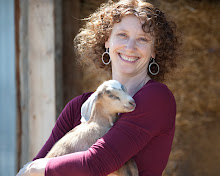

EEEEEE! I’m on the COVER of the May issue of Localflavor (localflavormagazine.com)! Wow—they said such nice things about me (Editor’s Letter, p 7), featured a cute picture of goat Sula (contents page, p4), and just did an incredible spread (“Land of Milk and Honey” p10-12). Although I would dispute that my life really is a “romantic tapestry”, I’m very flattered anyway. Gail Snyder, the author of the article did a great job describing my childhood influences on my present-day lifestyle. I think I’ll elaborate and pay tribute to those mentioned in passing in the article.
Without a doubt, the most influential experience of my childhood was growing up living at the Exchange Place, in Kingsport, Tennessee—see picture postcard, above (www.exchangeplace.info --hurrah for the web!). Gail very accurately described it as a “living museum” of 1850’s life—log cabins, barns, a sweet pasture behind the homestead with a creek running through it and magical woods. My mother was (still is) a craftsperson; back then she was weaving and spinning and designing textiles. (As an adult, I now completely appreciate my early exposure to fiber arts through my knitting—I knit the wool sweater in that cover shot.) Sheep were a big part of growing up, although we didn’t have any living with us back then. (Now the Exchange place has a very sweet flock.) I was surrounded by people making things by hand—some who did it for historical reasons, to learn traditional methods (coverlet weaving, quilting, tool-making, etc—think the “Foxfire” books), and some who did it for artistic reasons, learning the traditional skills in order to enhance their modern artistic visions. Vegetable-dyeing wool, spinning, basket weaving, woodworking and pottery were constantly in my surroundings and practiced by my mother’s artist friends. As an only child, I spent a lot of time hanging out with the various adults who came to work at the Exchange Place, including Jim and Tom, builders who specialized in restorative construction, rebuilding, after extensive research (in this case), the old log cabins, by using the traditional building methods and materials.
Not only did I get to know so many interesting and creative people, but I developed a deep appreciation of things created by hand—things that were made for everyday use, and yet were works of art by highly skilled people. I learned to value the old way of doing things—not only do you make something by hand, but you gather or raise or grow the materials it is made from, and you process it by hand—in weaving terms, “from sheep to shawl.” Animals are often involved, giving the end product the history of a sweet personality, and creating things in this vein connects you not only to local history, but to the history of humans creating things out of necessity and love and artistic impulse all over the world.
Oh, and to top it all off? My little hometown of Kingsport, Tennessee, is about 45 minutes (if I remember right) from The Carter Family Fold (www.carterfamilyfold.org --wow, the web), also known as the home of the legendary Carter Family, only those very folks credited with “giving birth to country music.” Talk about tradition! So I was also steeped in old-timey mountain music—I mean it was everywhere, and I grew up loving it.
So there’s a little of my history, and although I never raised goats (had one only briefly as a child), and never made soap (kind of surprising), there is no doubt that what I do now can be traced right back to these beginnings. Obviously the “sheep to shawl” concept, as well as looking back to traditional lifestyles, has given way to the Farmers Market movement of local, sustainable, organic—doing things the old way, it turns out, has a lot of wisdom to it.

Hello! I'm a friend of your mother's, a fellow Book Babe + use + love your soap whenever I'm over at her studio. I'll have to spend some time reading your blog because it s0unds like you have a wonderful + interesting life. At least that's how your proud mom portrays you.
ReplyDelete~Shona